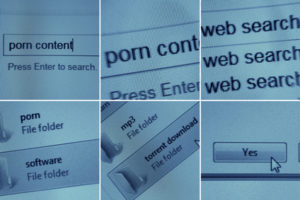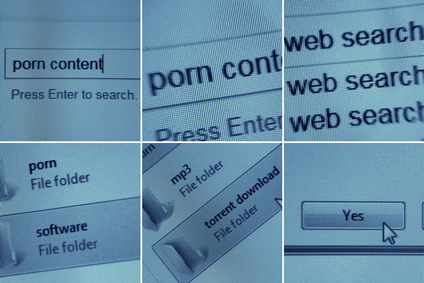
In a strange but true way, there was a study published in the Journal of Sex Research that found a correlation between some measures of religiosity and Google searchers for the term “porn.” In states with higher percentages of Evangelical Protestants, theists and biblical literalists—as well as states with higher church attendance rates—predict higher frequencies of searching for “porn.” Higher percentages of religiously unaffiliated persons in a state are related to lower frequencies of searching for porn. “Our findings support theories that more salient, traditional religious influences in a state may influence residents-whether religious or not-toward more covert sexual experiences.”
The above discussed study, “Unbuckling the Bible Belt: A State-Level Analysis of Religious Factors and Google Searches for Porn,” raised some questions when I saw graphics from the study on Twitter. Here is the link to the Twitter post. The linked study abstract and graphic on Twitter may be somewhat deceiving, as they plot and discuss searches done for the actual word “porn,” which could be done for a variety of reasons besides just wanting to view pornography. Yet the concern over the adverse social and spiritual effects of viewing pornography is a very real concern among a wider audience than just Evangelicals, theists and biblical literalists.
The state of Utah passed a resolution in March of 2016 declaring that pornography was a “public health hazard.” The resolution recognizes pornography leads to a broad spectrum of individual and public health concerns. It pointed to how young children are increasingly exposed to pornography, with the average age of exposure now 11 to 12 years of age. This early exposure leads to a multitude of personal and social problems, including: adolescents engaging in risky sexual behavior; an increase of sexual behavior at a younger age; depicting women and children as sex objects and rape and abuse as if they were harmless.
Writing for the Evangelical website The Gospel Coalition in May of 2016, Joe Carter described how pornography is increasingly being seen as a public health problem. Studies from the late 1960s to the mid-1980s concluded pornography had “no marked social effect.” But that was before the Internet. Since the late 1980s, there has been a wealth of social science research demonstrating the negative effect of porn on individuals, families, children and communities. Carter linked two meta-analyses that found sexual aggression among males and females was associated with the consumption of porn; and an overall positive association between pornography and attitudes supporting violence against women.
In “The Science of Pornography Addiction,” Gary Wilson described the effects of watching porn on the brain. He said that 25% of all Internet searches are for porn. It is the fourth most common reason people give for going online. In many ways, it acts like a drug. With prolonged exposure, it will lead to tolerance, loss of control and the compulsive desire to seek it out despite negative consequences. And there is “withdrawal” when it goes away. “The issue is that continued exposure can cause long term or even life-long neuroplastic change in the brain.”
There is a release of dopamine in our brains as a reward whenever we accomplish something, including sexual activity. “It alters and forms the brain cells to motivate certain actions. It rewires your brain.” The more time you spend doing a certain action, like viewing porn, the more dopamine is released—which then reinforces the behavior. As you begin to imagine the images away from the computer or while having sex, they become reinforced as well. “It’s a feedback loop that becomes harder to escape.”
The good news is this can be reversed or extinguished. Wilson said the brain is often described as “the use it or lose it system.” Like with muscles, the neural connections you use become stronger and want to be activated, while the ones you ignore become weakened. So the same neuroplastic system used to acquire these habits can be used to acquire healthier ones.
In another article on pornography and the brain, Joe Carter recommended “The Science of Pornography Addiction” video. He also summarized the thoughts of William Struther, an associated professor of psychology at Wheaton College. Commenting on the dopamine process described above, Struther said: “Pornography thus enslaves the viewer to an image, hijacking the biological response intended to bond a man to his wife and therefore inevitably loosening that bond.” Overstimulation of the reward circuitry, as when repeatedly viewing pornography, creates desensitization. “When dopamine receptors drop after too much stimulation, the brain doesn’t respond as much, and we feel less reward from pleasure.”
The psychological, behavioral, and emotional habits that form our sexual character will be based on the decisions we make. . . Whenever the sequence of arousal and response is activated, it forms a neurological memory that will influence future processing and response to sexual cues. As this pathway becomes activated and traveled, it becomes a preferred route—a mental journey—that is regularly trod. The consequences of this are far-reaching.
Internet porn is unique in a number of ways. First is its extreme novelty. Second, unlike food or drugs, there is almost no physical limit to its consumption. Third, a user can easily escalate to more novel “partners” and unusual genres. Fourth, unlike food or drugs, the brain’s natural aversion system is not activated. Like with drugs, the age users start using porn is a crucial factor. “A teen’s brain is at its peak of dopamine production and neuroplasticity, making it highly vulnerable to addiction and rewiring.”
A nonprofit organization called Fight the New Drug is trying to raise awareness on the harmful effects of porn and get this information to a wider audience. They use science, facts and personal accounts to bring the issue out in the open and get people talking about it. The organization’s website said not only are we the first generation to face the issue of pornography at this intensity and scale, “we’re also the first generation with a scientific fact-based understanding of the harm pornography can do.”
Then there is Elizabeth Smart. On June 5, 2002 when she was 14, Elizabeth was awakened by a strange male voice saying that he had a knife to her neck. She was told to get up without making a sound and come with him or he would kill her family. She remained a captive by this man and his wife for nine months, where she was repeatedly raped by the man. Sometimes he brought her hardcore porn, which he looked at and forced her to look at. Then he acted out with her what they had seen. Here is a short video of Elizabeth telling her story.
Looking at pornography wasn’t enough for him. Having sex with his wife after he looked at pornography, it wasn’t enough for him. Then it led to him finally going out and kidnapping me. He just always wanted more. I can’t say that he would not have gone out and kidnapped me if he had not looked at pornography. All I know is that pornography made my living hell worse.
The morning following her rescue, her mother gave her a piece of advice that changed her life. She told Elizabeth the best punishment she could give to the people that did those things to her was to be happy. Elizabeth went on to become an advocate for abuse prevention and an advocate against pornography. She married in 2012 and gave birth to a daughter in February of 2015.
P.S. Elizabeth Smart lived in Utah when she was abducted.





